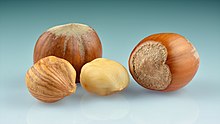**Hazelnut Description and Cultivation**:
– Hazelnut cob is spherical to oval, with a husk surrounding a smooth shell.
– Hazelnuts have been cultivated since the Mesolithic era, with evidence dating back to 6000 BCE.
– Traditional cultivation methods like ‘brutting’ and propagation from root sprouts are common.
– Various cultivars like Atababa, Barcelona, Butler, and Clark are grown for specific qualities.
– Hazelnuts are traditionally grown as multi-trunk trees in Europe, with some cultivars being hybrids.
**Hazelnut Cropping and Harvesting**:
– Hazelnuts are harvested annually in mid-autumn using manual or mechanical methods.
– Equipment like sweepers, harvesters, and nut carts are used for efficient harvesting.
– Herbicides are used to prevent yield loss from weed competition.
– Cover crops are employed to protect soil and suppress weed growth.
– Cropping systems like silvopastoral and silvoarable may introduce new revenue sources.
**Hazelnut Production and Food Uses**:
– Specific data for world hazelnut production in 2021 is unavailable.
– Hazelnuts are used in various confections like pralines, truffles, and paste products.
– They are common in dishes like Austrian tortes, French dacquoise, and Turkish cuisine.
– Hazelnuts are rich in essential nutrients, fats, and provide significant energy.
– Different flavors of hazelnuts are influenced by freshness and can be eaten fresh or dried.
**Hazelnut Nutrition and Health Benefits**:
– Raw hazelnuts contain water, fat, carbohydrates, and protein.
– They are a rich source of essential nutrients like protein, fiber, vitamin E, and more.
– Hazelnuts are high in monounsaturated and polyunsaturated fats and contain B vitamins, vitamin K, and minerals.
– Consuming hazelnuts may reduce the risk of heart disease, improve cholesterol levels, benefit skin health, and aid in weight management.
– Studies suggest hazelnuts have anti-inflammatory properties and support gut health.
**Hazelnuts in Culture and Research**:
– Hazelnuts have literary references in works by various authors.
– Studies focus on hazelnuts’ genetic markers, historical uses, and their role in different cuisines.
– Research includes hazelnut cultivation practices, rootstocks, and weed control strategies.
– Hazelnuts are recognized for their health benefits, including antioxidants and healthy fats.
– They have historical and cultural significance, making them a subject of interest in various contexts.
The hazelnut is the fruit of the hazel tree and therefore includes any of the nuts deriving from species of the genus Corylus, especially the nuts of the species Corylus avellana. They are also known as cobnuts or filberts according to species.

Hazelnuts are used as a snack food, in baking and desserts, and in breakfast cereals such as muesli. In confectionery, they are used to make praline, and also used in combination with chocolate for chocolate truffles and products such as chocolate bars and hazelnut cocoa spreads such as Nutella. They are also used in Frangelico liqueur. Hazelnut oil, pressed from hazelnuts, is strongly flavored and high in monounsaturated fat. It is used as a cooking oil and as a salad or vegetable dressing.
Turkey is the world's largest producer of hazelnuts, accounting for 64% of total production in 2021.
